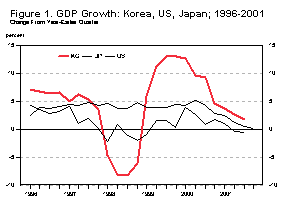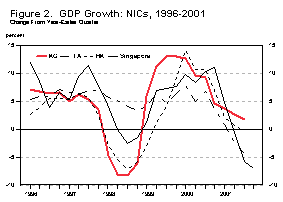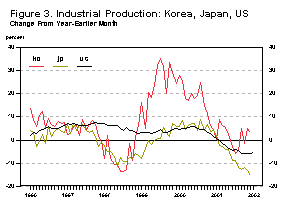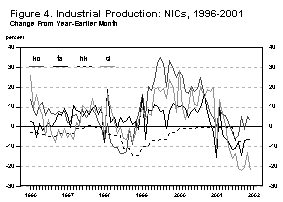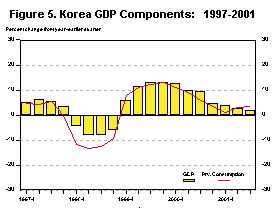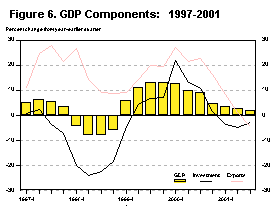|
[Editor's note: We gratefully acknowledge a generous contribution, with a
written permission, of this paper of William B. Brown to ICAS. This paper was delivered to the Kim Dae-jung Peace
Foundation for the Asia-Pacific Region, February 25, 2002.
sjk] Kim Dae-jung's Reforms and Challenges Ahead William B. Brown 1 This is a very broad subject and one important to a lot of people. I want to hasten to say that my position is very much as an interested outside observer, having watched the Korean economy grow ever since I lived here as a child in the 1950s. I am by no means an expert on all of the specific issues being faced by the Korean banking system and will address this topic in rather general terms, hopefully understandable to people who are not economists. I also should point out that these remarks are my own and should not be construed as implying an official position of the Commerce Department or the US government more generally. I'd like to congratulate the organizers of this conference for putting in one panel these three topics--democracy, capital markets, and the creation of a decentralized society with respect for each individual person. Often misunderstood, the creation of efficient, stable, and fair capital markets is a critical ingredient in building a modern democracy. Weak or poorly functioning banks and other financial institutions breed corruption and inefficiency, and often lead to monopoly profits for those who already have extreme wealth. I think most would agree in saying that the absence of properly operating capital markets robs the citizens of the chance to be full players and partners in a country's economy. This morning I want to present this topic as both a challenge and as an opportunity for Korea. President Kim Dae-jung's administration has made substantial progress in improving capital markets in Korea but I think we all recognize there is still much to do. And time may not be on our side. Over the past five years we have witnessed much turmoil in the capital markets of the smaller, trade-oriented Asian countries, including Korea. These systems now seem to be in better shape and have vastly increased their reserves. I'm not sure, however, that they have become more efficient and, to a degree, the huge reserves represent tied-up capital that no longer serves to build physical and human resources. And most troubling are the circumstance of the two giant economic systems in this region, Japan and China, whose banking systems continue to have enormous problems. There is little doubt that the next five years will see big changes in how people in Japan and China use their banks and other financial institutions to save and invest their resources. Consider that in joining the WTO China has promised within 5 years to allow its vast population to deposit money in foreign banks on Chinese soil. As a result, Chinese will have many more choices about what to do with their savings. Money will be used more profitably in China and movement of funds in out of China will occur much more freely. China's own financial institutions will come under the enormous stress of international competition. And Japan has promised to completely rebuild its shattered banking system. Japanese money already is quite free to flow out of Japan, but a large share is now tied up in bad loans. If these are liquidated, again we will see much more fluidity in funds moving in and out of Japan. Its hard to guess how these parallel reform programs will work out but it is easy to imagine that the spillover, both good and bad, will envelop neighboring countries, including of course, Korea. As the saying goes, Korea's markets will be like shrimp among the whales. Another challenge that Korean financial markets may very well face in coming years is integration with North Korea. Many see this as a huge cost to Korea; I see it as a huge opportunity. North Korea currently is without any kind of functioning money and banking system and its people literally starve as a result. The government there forces the people to save, even at the cost of their own children's lives, and then consumes all of these savings in reckless activities. If South Korea can create its own first-class money and banking system, there is no reason that this system cannot be used to replace the defunct system in the North. And as South Korean money and credit institutions envelope the North, these institutions can prosper as a result of a larger market and the economies of scale that brings. On the other hand, if South Korean institutions remain weak, a competing monetary system may eventually develop in the North that will make long-term integration much more difficult and expensive. I'd like to suggest that Korea use these external challenges to build on the reforms that have already begun during the Kim Dae-jung administration. A first-class financial system can thrive no matter what happens in China, Japan and North Korea. If there is trouble in these countries, money will turn to where it is safe. And if there is prosperity, money will flow to where it can safely be invested. A logical mentor state for Korea during this period might be Switzerland, and Korea might aim at providing the kind of regional financial services role that Switzerland plays in Europe--a bit outside the regional system but, owing to highly effective banking standards and a responsible, well educated, and saving and investment oriented public--supporting the regional system and profiting greatly from it. This may sound like an unreachable goal given the current problems in Korea's own banking system. And I am reminded of a chart in Turner/Trompenaars' new book,Building Cross Cultural Competence in which Switzerland and Korea stand at opposite ends of the spectrum in terms of respect for laws and legal systems. Clearly a great deal of work has to be done at home first. But given the far more difficult problems that Korea has overcome in past decades, Koreans should feel confident that they can do this as well. The key to success, as it is in any market, is free and transparent competition-- allowing competition to develop among banks, between banks and direct capital markets, and between domestic and foreign financial institutions. Korea's current system seems to favor the large borrowers and investors who have played a very important role in building up the country. For the system to succeed in a more open and mature environment, however, it will have to compete much better for the resources of savers--otherwise these, mostly ordinary, people will put their funds elsewhere and the economy will stagnate. Decentralized competition--that is competition between large numbers of borrowers and large numbers of savers, none of whom have monopoly powers--will provide the efficiency, fairness, and stability that Korea needs to thrive over the coming decade. Korea's Current Economic Situation: Is a Recovery Beginning? My office in the US Department of Commerce follows current economic conditions, mostly in the United States, but we try to keep in touch with what is happening around the world. Whereas most of what I have to talk about today is Korea's longer-term challenges, let me say that, at least from our far-away vantage point, it looks like the Korean economy in the short-term may be turning the corner on the slowdown. Korea, and several other IT-intensive economies entered this downturn essentially simultaneously with the United States. I don't think it is fair to say one led the other--and this group of countries seems now to be regaining lost ground and perhaps is ready to begin another expansion.
Korea clearly was hurt by its dependence on memory chips in 2000 but now it is benefiting from the broad diversity of the rest of its industry, unlike some of its Asian neighbors which are more highly dependent on IT. And, perhaps more interesting, Korea's economy is being helped by fairly strong domestic consumer demand (Figures 5 and 6) rather than by the export and investment demand that usually propels the economy. This is similar to what is happening in the US, where consumer demand for interest rate sensitive items, like autos and housing, is holding up very well. For Korea, this means that the saving rate of the population continues on a declining trend and it may signal a certain maturing of the Korean economy and an important turning point for its capital markets.
Savings and Investment--the Yin and the Yang of the Korean economy The distinction between saving and investment is crucial to understanding the long-term situation in Korea and I want to make sure everyone here understands the difference, especially in translation. So let me carefully define these important words.
What did the writer of the Economist mean by that statement? Well, it does not mean that Korea is not a nation of savers. Korea's saving rates are equal to those of Taiwan's and are among the very highest in the world. Korea, however, typically takes these savings and invests them in building up its real capital stock. Not satisfied even with this amount of investment, Korean people and firms then borrow extensively from savers in other countries and invest these borrowed resources in the Korean economy as well, giving rise to the enormous build-up in the nation's stock of capital that all of us who visit Korea periodically are amazed to see. Taiwan, in contrast, is much more conservative. It takes a large share of its high rate of savings and buys foreign reserves, in effect letting investors in foreign countries, much of it in America, use their resources. The build-up of capital stock in Taiwan itself has thus been less than has occurred in Korea. The expansion of its economy has been more stable but ultimately much less impressive than has been Korea's.
New School and Old School Views of Korea's Miracle The economics profession in America had a big argument a few years ago about what caused the rapid growth in Korea and the rest of East Asia. The "new school" figured there was something "miraculous" about the strong role of government in guiding these countries' growth. Government sponsored investment in high technology and industries with large economies of scale had a lot to do with this argument. By interfering in markets, government policy managed to create very rapid and sustained growth. And with continued efforts by governments to promote economies of scale and new technologies, East Asia's rapid growth could continue and Japan, in particular, would become the richest country in the world. The mainline or "neoclassical" school, led by Paul Krugman of MIT, ironically a former "new school economist" himself, said no, the data convinced them that there wasn't anything miraculous about East Asia's growth. 2 The growth was simply a matter of Koreans and other Asians withholding consumption and putting a very large share of their resources to work, building-up the stock of human and physical capital stock. Since the increased output could be accounted for by increased inputs and by normal growth in technological progress, there was no unexplained "miracle". Since the growth could be explained, this entire process could be used as a model to be applied to other developing countries. Prophetically, this "neoclassical" theory also suggested that there were danger signals in the very rapid growth of investment in East Asia. As the stock of capital was growing so quickly, it was becoming more difficult to determine where new investments should be made, and therefore new capital was not likely to be used as effectively as the old capital. Returns on new investments and the profits of firms were tending to decline despite the economy's strong growth. If this trend continued, investment might start to flow to other countries where capital was more scarce and the returns higher--China being the most obvious potential destination of new capital. This process need not be a problem if savers and investors expect it to happen and price their transactions accordingly. Interest rates can fall and capital can flow abroad. An economy and society like Korea certainly can adjust to slower growth. But Krugman and others wisely warned that if expectations were too high, too much investment would take place. Initially that investment would be self-fulfilling, creating its own demand for investment products and thus economic growth. But eventually, too much investment would create much overcapacity and a debilitating slowdown or recession could follow. The subsequent Asian financial crisis and Japan's deep recession have, at least in my view, vindicated the "neoclassical" theory--that is that an economy grows the "old fashioned" way, by increasing inputs of labor, capital and technology. The key to sustained growth is a critical balancing act between the right amount of saving and the right amount of investing. Too much saving and too little investing will cause a recession--as we have now in much of the world--whereas, too little saving and too much investing may cause a speculative bubble that cripples the returns on new investments. 3 Korea's Banks: The Heroes of the 1960s . . . 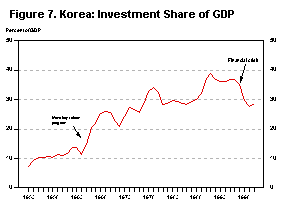 A key problem in creating the framework for sustained economic growth thus centers around the capital markets that bring
together these savers and investors. It is here where I disagree a bit with Krugman's idea that Korea's growth was not a
"miracle". To me the reform in public policy that occurred in Korea in 1961 and 1962 was close to if not miraculous.
Reform centered on creating a modern banking system that would create the correct incentives for ordinary people to save and
for other ordinary people to take those saved resources and invest them in building things that would make them more
productive. The reforms worked. By bringing savers and investors together and allowing them to do business, Korea's banks
presided over one of the largest turnarounds in economic development ever witnessed. As the figure 7 shows, Korea's
investment rose from a meager 10 percent of GDP in the early 1960s to 30 percent of GDP, one of the highest in the world, a
decade later.
4
A key problem in creating the framework for sustained economic growth thus centers around the capital markets that bring
together these savers and investors. It is here where I disagree a bit with Krugman's idea that Korea's growth was not a
"miracle". To me the reform in public policy that occurred in Korea in 1961 and 1962 was close to if not miraculous.
Reform centered on creating a modern banking system that would create the correct incentives for ordinary people to save and
for other ordinary people to take those saved resources and invest them in building things that would make them more
productive. The reforms worked. By bringing savers and investors together and allowing them to do business, Korea's banks
presided over one of the largest turnarounds in economic development ever witnessed. As the figure 7 shows, Korea's
investment rose from a meager 10 percent of GDP in the early 1960s to 30 percent of GDP, one of the highest in the world, a
decade later.
4Many of you here are probably too young to remember this change but I experienced it first-hand as an 11-year-old living in Kwangju, Chulla Nam-do. My dad, and most of the American families on our mission station, were out of town at an annual meeting when my mother got a message that we had to change all of our money. The next day the old hwan currency would be useless and we had to trade it all in for the new won currency--exchanged at 1300 hwan per 100 won. The problem was one of our neighbors, a missionary doctor, had called to say that he had stashed a large sum of his emergency cash in a hollowed out book in his library. He couldn't remember which book so he wanted us to go through all of them, find t he money and exchange it for the new won currency. Wow, this was a very exciting treasure hunt for an 11-year old; I can't remember if we found the money but I'm sure we made a mess of his library. 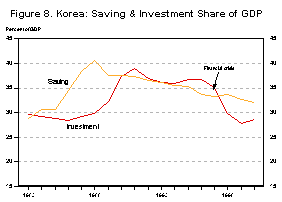 The point is, with the new banking system, the new money, when put in a bank, earned a high rate of interest, high enough to
encourage people to save money and deposit it in the bank. These savings could be lent to others willing to invest them.
Poorly used resources suddenly shifted from being spent on funerals, or hidden in library books, to being used to build
stores and factories. The borrowers paid high interest rates but with so little capital in Korea, a little borrowed capital
could earn very high real returns. Almost overnight, farmers shifted from using shovels and oxen to plow their fields to
using little tractors that were assembled in Korea from imported parts. The government and the banks were careful to lend
only to those who proved they could invest these precious resources wisely, preventing defaults from taking place and the
banks losing the invested money. Within a decade of this policy change, Korea had progressed from one of the least saving
countries in the world to one of the highest.
The point is, with the new banking system, the new money, when put in a bank, earned a high rate of interest, high enough to
encourage people to save money and deposit it in the bank. These savings could be lent to others willing to invest them.
Poorly used resources suddenly shifted from being spent on funerals, or hidden in library books, to being used to build
stores and factories. The borrowers paid high interest rates but with so little capital in Korea, a little borrowed capital
could earn very high real returns. Almost overnight, farmers shifted from using shovels and oxen to plow their fields to
using little tractors that were assembled in Korea from imported parts. The government and the banks were careful to lend
only to those who proved they could invest these precious resources wisely, preventing defaults from taking place and the
banks losing the invested money. Within a decade of this policy change, Korea had progressed from one of the least saving
countries in the world to one of the highest.President Kim Dae Jung said in a terrific speech that I heard him give at Georgetown University several years ago, that Confucianism, or Asian Values had little to do with Korea's economic turnaround. That is unless Asian values really are the universal values, such as democracy, human rights, and capitalism. After all, poverty stricken Korea was just as Confucian in 1959 as it was in 1965, or as it is today. I would simply add, that creation of a good money and banking system contributed a lot to the building of these universal values in Korea. . . . but the Failures of the 1990s 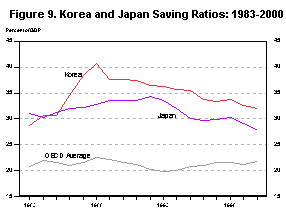 President Kim inherited an economy in 1998 in which banks were being accused of contributing to if not causing an
economy-wide financial melt down. The charges were not without merit and by now the Korean people have spent something like
150 trillion won to bail out these banks, their depositors, and the borrowers. This cost is comparable to the cost to
American tax payers of bailing out our insolvent savings and loan banking system in the early 1980s, but our economy is 20
times or so larger than is Korea's so proportionally the problem for us was much smaller. What caused Korea's banking
system, that helped to create so much wealth in the 1960s and 1970s to come apart so fundamentally in the 1990s?
President Kim inherited an economy in 1998 in which banks were being accused of contributing to if not causing an
economy-wide financial melt down. The charges were not without merit and by now the Korean people have spent something like
150 trillion won to bail out these banks, their depositors, and the borrowers. This cost is comparable to the cost to
American tax payers of bailing out our insolvent savings and loan banking system in the early 1980s, but our economy is 20
times or so larger than is Korea's so proportionally the problem for us was much smaller. What caused Korea's banking
system, that helped to create so much wealth in the 1960s and 1970s to come apart so fundamentally in the 1990s?We have a saying in America "If something ain't broke don't fix it". Like many such sayings there is in it a little that is true and a lot that is false. It is difficult to reform a system that seems to working adequately. In the 1970s Koreas' banks were flush with depositor's funds and were lending these deposits to firms building up their export capabilities. By the 1980s this lending had become highly concentrated among those firms that were successful in their export development, the chaebols. The system made it easy for successful companies to get credit and grow larger and it made it nearly impossible for new or smaller firms to get the credit they needed to challenge or compete against established firms. So the larger firms kept getting even larger and the smaller firms withered away. In a period, such as the 1960s, when credit and foreign exchange were scarce, this system made some sense. But by the 1990s, it simply made competition, except between the chaebol firms themselves, impossible. The once trim and energized chaebols became fattened by credit that was too easy. In what economists understand as oligopoly or rival based competition, their only motivation for investment became one of not being outdone by rival chaebols. Each created similar organizations with similar product lines and similar technologies. If Hyundai Heavy Industries built ships, then Daewoo would also. If Samsung made semiconductors, Lucky Gold Star, Hyundai, and Daewoo each would also. The Korean chaebols have thus become a textbook case of oligopoly competition. And is often the case with oligopolies, especially when they have nearly unlimited access to a country's credit, they created much overcapacity for their products. Prices fell and the firms were rarely very profitable. 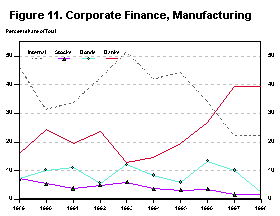 The dominant position of relatively few banks backed by the government also created a situation in which the development of
other kinds of capital markets, especially more efficient direct markets, were unnaturally constrained. Banks are important
institutions for encouraging saving and for providing credit to the consumer sector. But, like any retailer, they are not
always the most efficient in handling large volume products. They have high fixed costs and, because they carry implicit or
explicit government guarantees, they accept too much risk on the behalf of their depositors. The domination of banking by a
few banks, combined with an unwillingness of chaebol families to sell equity to the public, and thus risk loosing control,
has given Korea's legendary savers poor options for making higher risk, higher return investments. Corporations have had to
rely on expensive and inflexible bank loans for too much of their investment needs. In other words, Korean capital markets
have offered a very unappetizing menu to Korea's borrowers, savers, and investors alike.
The dominant position of relatively few banks backed by the government also created a situation in which the development of
other kinds of capital markets, especially more efficient direct markets, were unnaturally constrained. Banks are important
institutions for encouraging saving and for providing credit to the consumer sector. But, like any retailer, they are not
always the most efficient in handling large volume products. They have high fixed costs and, because they carry implicit or
explicit government guarantees, they accept too much risk on the behalf of their depositors. The domination of banking by a
few banks, combined with an unwillingness of chaebol families to sell equity to the public, and thus risk loosing control,
has given Korea's legendary savers poor options for making higher risk, higher return investments. Corporations have had to
rely on expensive and inflexible bank loans for too much of their investment needs. In other words, Korean capital markets
have offered a very unappetizing menu to Korea's borrowers, savers, and investors alike.If this were simply a problem of industrial firms making unwise investments we could say that the markets have by now taught them a lesson. The valuation of their stocks is small, probably less then the value of the retained earnings they put into building their firms. But we must acknowledge that the banking system--that provided easy credit to chaebols and little credit to anyone else--also was responsible. Since their lending was so concentrated to the chaebols, if a single chaebol began having problems paying interest, the banks simply loaned them more money to cover the interest. If they did not, and a firm defaulted on a loan, the whole system of loans could be put into default and the bank would have to accept big losses. So good money followed the bad and eventually a enormous pile of bad debt pilled up, hidden by poor accounting standards. When the Hanbo Steel chaebol and a few others started to crack in early 1997, the Kim Young Sam government actually played the issue in a tough and responsible manner and soon these problem firms were allowed to fail. One failed loan cascaded into another, however, and the entire banking system came into risk. Eventually, coupled with big problems in Southeast Asia, creditors panicked and pulled their funds out of Korean banks any way they could manage. Bringing Competition into Capital Markets The new Kim Dae-jung administration quickly restored order in the capital markets by promising reforms to the IMF and by securing huge IMF and other member country credits. The government quickly acknowledged the fault of the banking system and has been providing public funds to keep the financial system from freezing up. Credit is still available for creditworthy borrowers. This is exactly what Japan's succession of governments has not done. Further, the Korean government has been active in closing and reorganizing banks, even inviting in foreign banks to step in and take over failing Korean banks. Of the 33 commercial banks that existed in 1997, 11 have disappeared, leaving 22 banks that are somewhat stronger. These are emergency steps which have worked well to restore confidence in Korea's financial system. Also important are changes forced upon the Chaebol structure as many large groups were forced to break apart. Daewoo was essentially allowed to go bankrupt, as were large parts of Hyundai. Firms were encouraged to focus on economies of scale, trimming their far-flung empires. As economic growth quickly returned, the government concentrated its policies on restoring confidence in the overall system, raising foreign exchange reserves to record levels. It has maintained conservative fiscal policy, except for the bank bail outs, and has kept the exchange rate at a low, and I think quite competitive rate. All-in-all this administration has achieved a quite strong economic performance in very difficult circumstances. I mentioned earlier, however, that Korea cannot afford to rest in its pursuit of truly first-class financial markets. Continued profitability problems with the chaebols, and still large bad loan problems for the banks, added to the potential challenges, mentioned earlier, from Chinese and Japanese banking reform, and the issue of North Korea, add a sense of urgency Fortunately, there is little doubt about the direction Korea needs to move in - the direction in which it is in fact headed. The questions that remain are the speed of this transition to liberal capital markets and the completeness of the transition. I would suggest the goal should be to move as quickly and as completely as possible. What are the steps on the way? Any market system depends, fundamentally, on competition between many independent players. Capital markets are no different. Banks need to compete with many other banks for the deposits of savers. The banking system, moreover, must compete with other financial markets, such as stock and bond markets, for savers funds. In Korea this has been one of the most important shortcomings in recent decades. And Korea's financial system must compete with foreign financial systems for the funds of both Korean and foreign savers. This is what is meant by full convertibility on the capital account. Of course, all the same things can be said about borrowers. Korean borrowers should be able to compete for sources of funds. They should have much more choice as to whether to sell of some of the risk and future profits, as in buying equity, or in keeping all the risk and all the profits to themselves, as in taking a bank loan. Korea is just about there but there are still some important issues that need to be resolved. Let me speak very quickly about each of these competitions. Too Big Too Fail, Does Korea Need More Not Fewer Banks? One issue that is worrisome is how the government sorts out the problem of bad loans and competition between big banks. One solution to the bad loan problem, used widely in the United States, in Japan, and now in Korea, is to merge banks with many problem loans into banks that are in better shape. I am not sure that this is the best approach. The United States seemed to succeed in this process, especially after the Savings and Loans debacle of the early 1980s. But the US has many thousands of banks. In 1994 the figure was something like 13,000 although many have merged since then. After the Great Depression of the 1930s, we reformed our banking system into one in which banks could only do local or at most state-wide business. This created something of a firewall so that regional problems would not automatically travel rapidly across the country. Most of the larger banks were tied together through the Federal Reserve System but no one bank or even a group of a dozen or so banks were important enough to harm the general economy should they fail. After the Great Depression, failures were not common but they happened. Depositors were paid off through the federal deposit insurance program and shareholders lost all of their equity. Whatever was left of the failed institution often was merged with a healthy bank, and business usually continued without much interruption. Japan and Korea, in contrast, have very few banks--Korea has only 22 commercial banks, many fewer than in just the Washington D.C. area--and deposits are highly concentrated in just a few of these. When banks in such a concentrated system are then merged, the number falls even further and competition loss is significant. When any of these very large banks get in trouble, the whole national economy is affected. Suppose, for example, a very large bank has to foreclose on large real estate loans. The size of the loans and the properties themselves are so large that if they are liquidated, the value of the property drops sharply. This is what keeps happening in Japan. In the 1980s, the big banks kept loaning funds for real estate ventures. The purchases were so big, the price of real estate rose every time the banks made new loans. The higher prices then justified still more loans to the developers and prices climbed even further in an upward spiral. But then, of course, we all know the rest of the story. Prices spiraled downward as big banks unloaded real estate in the 1990s. And as prices fell, banks were forced to sell more real estate, so prices fell even further. This is a problem with banks that are far too large for their marketplace. Normal competitive dynamics of supply and demand fail to operate correctly. Perhaps even worse than this possibility of a downward spiral in loan activity is the fact that everyone knows that the government is likely to step in and save the bank or the borrower before too much damage occurs. This "moral hazard", as it is termed in the industry, can cause extremely risky behavior on the part of either the bank or the investor. Knowing that there is a line below which it won't be held responsible for losses, a bank that is close to that line gambles wildly on high risk borrowers. If the bets pay off, the bankers get rich. If the bets fail, then the bank risks not failure but a bail out by the government. This perverse kind of activity is not peculiar to any country or culture. It happens wherever a government or larger authority guarantees a risky activity without getting a share in the profits if the risk pays off. This is a good argument for Korea finding a way to promote more not fewer banks, making sure that each operates independently of one another and independently of the government insurance mechanisms. Of course small banks may seem to be inefficient, and often they are, but modern information technology is helping to level the playing field between smaller and larger banking institutions. Many banking services today are provided by intermediate firms that can sell to small or large banks alike. For instance, a small bank can purchase exactly the same ATM access as a large bank. You might think there is some advantage for me to have the card of a major US bank here in Seoul but actually there isn't. A local community bank's ATM card works fine. The same can be said for credit or money cards, internet access, etc. And with a sound central bank reserve system, a small bank is no more risky than a large one. Some argue that in the US, as an example, that small banks tend to be more profitable and better managed than large ones. Korea has a long history of village and neighborhood bank-like institutions. These often fail, however, due to their inability to lend money strictly on the merits of the investment--that is the expected ability of the borrower to repay the loan. In order to cover the large losses of some of the loans, others pay very high interest rates and depositors get low rates of return. This is a very inefficient and ultimately unfair system. So clearly I don't mean Korea should move back to that tradition Clearly, high standards in banking means lending on the basis of merit, not on the basis of politics or personal relationships in either large or small banking institutions. Direct Capital Markets, the Wave of the Future Competition with the entire banking system from direct capital markets also is needed if Korea is to develop a first-rate financial system. Banks are good institutions for encouraging saving and are convenient for bringing small-scale savers and borrowers together. There is no question any economy needs banks and lots of them, but they essentially act as middle men and distribute their costs between both the saver and the borrower, adding a costs to any such transaction. These costs often are not small since banks tend to have high overhead, with their large buildings, many branches, and substantial staff. (In the US this cost is easily seen in the gap between a deposit rate--today only about 1 percent--and a bank card loan rate, about 10 percent.) Of course the bank also absorbs some of the risk of non-payment. The loan activity is thus a three-way shared risk between depositor, borrower, and bank shareholder. More often than not, however, the bank shareholder is, in effect, the general public. The public is thus absorbing risk and not receiving a benefit, in effect giving a subsidy to the saving and borrowing activity. This subsidy encourages more saving and more investment then may be warranted. Given Korea's recent history, one might argue that the public has been an unwitting player in the midst of a lot of high risk loan activity by banks. I think there is little question that direct capital markets should be playing a much more important role in Korea. In the US the banking sector accounts for about 20 percent of all financial transactions; in Korea the figure is well over 50 percent. Figure 11 shows the trend in Korea has been, if anything, in the wrong direction, with bank loans being used to cover larger shares of corporate investment. Direct markets are important for several reasons. For large borrowers and savers, direct markets are much more efficient, since bonds or other financial instruments can be issued without the requirement of a middleman adding to the costs. If a company sells a bond that pays 10 percent, it knows that it will have to pay exactly that rate and the buyer of the bond knows he or she will get pretty close to 10 percent. There is little transaction cost and the transaction is thus very efficient. More importantly, the buyer of the bond knows that he or she is accepting some of the risk should the borrower be unable to pay when the bond comes due. The cost of the bond and thus the interest rate are intimately connected to the creditworthiness of the seller. This thus makes for an efficient and fare transaction with little impact on the broader public. Creating an excellent stock or equity market is another key element in building a solid financial system in Korea. Of course Korea has had a stock market for many years but due to the dominant position of banks and their willingness to loan almost without end to the families that owned the chaebols, stock issuance has been unnecessary and therefore very small. The thin stock market has therefore been very volatile, almost more of a gambling institution than an institution for raising capital. Korea is not alone in this regard. Most Asian stock markets are poorly developed relative to the state of development of the rest of the economy. This again is why I believe Korea is in a good position to pull ahead of the region if it makes the right policy moves at this time. Even more than bonds, equity transactions make the lender take on much more of the risk in a given transaction and are thus ideal vehicles for financing high-risk developments where the borrower/investor has limited resources but excellent potential. The lender (the buyer of the equity) takes on the risk but also gains a large share of the potential profits, again creating an ideal situation for pricing risks correctly and adequately rewarding investment activities. Stock ownership, moreover, makes ordinary citizens more vested in the system, and is thus an important feature of any democratic economy. Despite their inherent transaction efficiency, stock and bond markets require much better information than does old fashioned banking. A key role of the banker is to gather information about borrowers on which to make intelligent lending decisions. This information may often be private and subject to corruption and unfair dealings. Since stock and bond markets are direct markets, buyers must rely on an entirely different system of information collected and published by auditors, accountants, brokerage companies, market research firms and the like. In advanced countries of Europe and America, a whole industry has developed that tries to provide the best information possible to guide investors, though as we see in the controversy over the Enron case, there is still plenty of room for improvement. This is probably the area where Korea needs to work the fastest and the hardest if it is to build a first class financial system. Substantial improvements have been made in recent years but my guess is that there is still a long way to go. Korea would appear to be well suited to build up such an industry and obtain excellent high paying jobs for many of its college graduates. Again a big advantage for Korea may be the weakness in this area of neighbors. China, especially, will be in great need of financial services and likely it will have to import many of them. Foreign Direct Investment, Much Progress from a Slow Start Let me turn now to an area where Korea has shown excellent progress in the Kim Dae-jung era, though as in others, there is considerable work to do. The issue is foreign direct investment, more commonly noted simply as FDI. There are two kinds of FDI; that which flows out of a country, buying controlling interests in overseas firms, and FDI that flow into a country, when foreign firms buy controlling interests in firms in the host country. 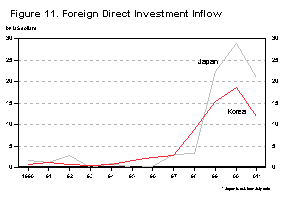 The following facts may surprise you a little. Which two countries regularly receive the largest inflow of FDI? Every year
of the 1990s it has been the United States and China, far ahead of any others. Which countries have been the largest
sources for FDI outflow? The US is the largest source country; the second often is the Netherlands or Japan. Now let me
change the question. Which two countries in the whole world are the weakest hosts of foreign FDI, at least relative to GDP?
The answer for most of the post war period has been Japan and Korea. These two countries have been active in buying assets
abroad but for a variety of reasons have never welcomed substantial foreign owned operations in their home countries.
Koreans tell me it has a lot to do with Japan; that is Korea has been worried that it could easily be dominated by Japanese
firms and thus set up rules and customs that would make it difficult for foreign firms to operate here. There is some
foundation for those concerns, I must admit, at least through the 1980s. Japan and Korea also are the only non-Western
countries to have created big, name brand multinational corporations in the post war period. Had they allowed western firms
to buy in early, we might never have seen big companies named Samsung, Hyundai, Lucky, Gold star, Daewoo, etc.
The following facts may surprise you a little. Which two countries regularly receive the largest inflow of FDI? Every year
of the 1990s it has been the United States and China, far ahead of any others. Which countries have been the largest
sources for FDI outflow? The US is the largest source country; the second often is the Netherlands or Japan. Now let me
change the question. Which two countries in the whole world are the weakest hosts of foreign FDI, at least relative to GDP?
The answer for most of the post war period has been Japan and Korea. These two countries have been active in buying assets
abroad but for a variety of reasons have never welcomed substantial foreign owned operations in their home countries.
Koreans tell me it has a lot to do with Japan; that is Korea has been worried that it could easily be dominated by Japanese
firms and thus set up rules and customs that would make it difficult for foreign firms to operate here. There is some
foundation for those concerns, I must admit, at least through the 1980s. Japan and Korea also are the only non-Western
countries to have created big, name brand multinational corporations in the post war period. Had they allowed western firms
to buy in early, we might never have seen big companies named Samsung, Hyundai, Lucky, Gold star, Daewoo, etc.As with most extreme policies, however, there has been a substantial cost. FDI inflow, in other words, the foreign managed firms operating within any domestic economy, is a proven inducement to competition, especially in the management of corporations. Foreign firms, including many Korean firms, operating in the United States have made American firms much more competitive both at home and in the world economy. Korea and Japan often lack this competition at home to encourage the building of solid corporations. As a result Korean and Japanese firms typically operate much better overseas, in the midst of extreme competition, than they do at home. 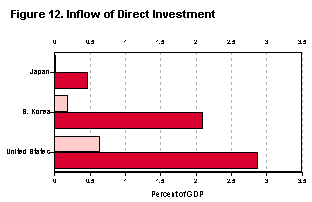 The other issue has to do with finance. Instead of allowing foreign firms to buy equity in Korean firms, or to buy Korean
property, Korean firms have borrowed extensively from foreign banks and used those proceeds to build capacity. By borrowing,
Korea takes most of the risk. Again, that is what makes Korea a country of investors and borrowers rather than savers and
consumers, as I mentioned earlier. As with domestic banks, however, this policy has put enormous risks on the Korean firms
that have borrowed and by the banks, domestic and foreign, which have made the loans. Foreign banks, in particular, can feel
exposed to such loans and pull funds out quickly. That is essentially what happened in late 1997 when the financial system
here just about came unglued.
The other issue has to do with finance. Instead of allowing foreign firms to buy equity in Korean firms, or to buy Korean
property, Korean firms have borrowed extensively from foreign banks and used those proceeds to build capacity. By borrowing,
Korea takes most of the risk. Again, that is what makes Korea a country of investors and borrowers rather than savers and
consumers, as I mentioned earlier. As with domestic banks, however, this policy has put enormous risks on the Korean firms
that have borrowed and by the banks, domestic and foreign, which have made the loans. Foreign banks, in particular, can feel
exposed to such loans and pull funds out quickly. That is essentially what happened in late 1997 when the financial system
here just about came unglued.Kim Dae-jung's response to the crisis has led to a dramatic change in attitude toward FDI in Korea. FDI is much more stable, and the foreign investor takes on much of the risk inherent in any investment. But, of course, it will only do this if it can keep its profits. Figure 11 shows the large upturn in FDI, both in value terms and as a share of GDP. You will notice that Japan also is rapidly changing its views of FDI. Renault's purchase of Nissan, and the revolutionary management changes that accompanied the purchase, have dramatically improved Nissan's outlook. FDI dipped in 2001 but this was largely related to the worldwide recession. Hopefully this upturn trend will continue this year. Five years ago I traveled here to Korea to give a speech down in Chonju on a similar topic. Governor Yun was hosting a conference trying to encourage more FDI in that region. I remember noting that I thought it was of vital importance that Kia Motors allow itself to be taken over by a foreign auto firm. Of course I hoped it would be Ford, which at the time was close to closing a deal. But I said it really didn't matter which foreign company took it over. Any foreign competition inside Korea would be good for Korean stockholders, workers, and consumers. The Ford bid failed soon after that and KIA collapsed, becoming one of the sparks that touched off the 1997 crisis. Now, five years later, GM and Micron, are bidding for troubled Daewoo Motors and Hynix, respectfully. Again there is lot of difficulty getting final approvals. My guess is that this time we will see a difference and the US firms will be welcomed here, not just as a means of obtaining the stable capital needed to keep these firms operating, but as needed competition for other Korean auto and semiconductor companies. Conclusion: It Korea's Turn I mentioned earlier that I listened to a speech given by President Kim at Georgetown University several years ago. He captured in his speech, much more eloquently than I ever could, most of the ideas I have presented in this paper. Key among them was the idea that capitalism and democracy were universal human values that were strongly supported in Korea. And for the most part his administration has pushed forward with reforms that will help Korean capital markets to work in a stable, efficient and fair manner. The job is still only half done, however. And looking around this Pacific region, one can see a great opportunity for whichever country can first establish excellence in its financial system. Six years ago--using an American football analogy--the financial markets of the region fumbled the ball. By now I think the ball has stopped bouncing around and everyone is looking at it. They know what to do but are hesitant to take the obvious step - pick it up and run with it. The biggest guys, Japan and China, are probably too slow to escape pursuit The Singapore city-state is in a good position but is probably too small to run very far. Hong Kong and Taiwan now have the big weight of China hovering over them, blocking them. This, in my view, leaves Koreans in a great position to take the leap and run with the ball With the right game plan, they should have a good opportunity to score a touchdown and win the game. With healthy competition in all sectors of its financial system, the Korean economy will be well prepared for the opportunities of the future.
|
